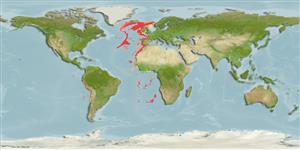Malacostraca |
Decapoda |
Geryonidae
Environment: milieu / climate zone / depth range / distribution range
Ecology
Benthic; depth range 130 - 2047 m (Ref. 2704), usually 200 - 2000 m (Ref. 78375). Deep-water; 64°N - 33°S, 81°W - 7°E (Ref. 2747)
Southeast Pacific and north Atlantic.
Length at first maturity / Size / Weight / Age
Maturity: Lm ?, range 8 - 9.926 cm Max length : 15.5 cm CL male/unsexed; (Ref. 101417); 17.7 cm CL (female); max. published weight: 863.00 g (Ref. 2720)
Maximum length for females from Ref. 2747. This is the largest epibenthic brachyuran crab of the Family Geryonidae (Ref. 2689). Bimodal length frequency for males and unimodal for females. More males and larger individuals in shallower substratum and increasing number of females and smaller individuals in deeper substratum (Ref. 2677, 2747). This is also a target species of gillnet operators in Northeast Atlantic fisheries (Ref. 2740). Inhabits a variety of bottom substrates from mud to rock (Ref. 2708, 2725 and 2747); at a depth of 700 m and deeper; it prefers soft substrata (Ref. 2753), and it is found on seamount and escarpments (Ref. 2740). Recruitment of individuals occurs in the deepest substrata. Sacculina sp. is parasitic on this species, infecting individuals in deeper substratum around 1000 to 1100 m (Ref. 2677). Males parasitized by Sacculina sp. are feminized behaviorally and morphologically (Ref. 2694), whereas females are castrated (Ref. 2696). Epibionts Poecilasma crassa and Poecilasma aurantia are found on the exoskeleton of the crab (Ref. 2747 and 2752). This is an allopatric species (Ref. 2763).
Life cycle and mating behavior
Maturity | Reproduction | Spawning | Eggs | Fecundity | Larvae
Inferred from the gonadosomatic index (GDI), presence of ovigerous females and evolution of the maturity stages, occurs in autumn and winter. This supports an annual reproductive cycle. Sexual maturity with carapace lengths from 7.3 to 9.7 cm (Ref. 2747, 2751).
Abellán, L.J.L., E. Balguerías and V. Fernández-Vergaz. 2002. (Ref. 2677)
IUCN Red List Status (Ref. 130435)
CITES status (Ref. 108899)
Not Evaluated
Not Evaluated
Threat to humans
Human uses
Fisheries: commercial
| FishSource | Sea Around Us
Tools
Internet sources
Estimates based on models
Preferred temperature
(Ref.
115969): 4 - 11.6, mean 8.2 (based on 168 cells).
Price category
Unknown.
Nutrients: Calcium = 109 [35, 184] mg/100g; Iron = 1.59 [1.21, 1.97] mg/100g; Protein = 20.2 [19.2, 21.3] %; Omega3 = 0.285 [0.185, 0.386] g/100g; Selenium = 48.3 [-31.7, 128.3] μg/100g; VitaminA = 0 μg/100g; Zinc = 1.79 [1.17, 2.40] mg/100g (wet weight).
